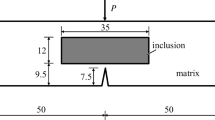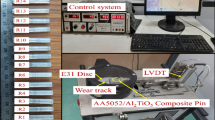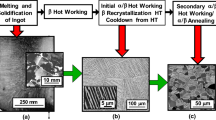Abstract
The loading/unloading tensile behavior of unidirectional C/SiC ceramic matrix composites at room temperature has been investigated. The loading/unloading stress–strain curve exhibits obvious hysteresis behavior. An approach to model the hysteresis loops of ceramic matrix composites including the effect of fiber failure during tensile loading has been developed. By adopting a shear-lag model which includes the matrix shear deformation in the bonded region and friction in the debonded region, the matrix cracking space and interface debonded length are obtained by matrix statistical cracking model and fracture mechanics interface debonded criterion. The two-parameter Weibull model is used to describe the fiber strength distribution. The stress carried by the intact and fracture fibers on the matrix crack plane during unloading and subsequent reloading is determined by the Global Load Sharing criterion. Based on the damage mechanisms of fiber sliding relative to matrix during unloading and subsequent reloading, the unloading interface reverse slip length and reloading interface new slip length are obtained by the fracture mechanics approach. The hysteresis loops of unidirectional C/SiC ceramic matrix composites corresponding to different stress have been predicted.








Similar content being viewed by others
References
Naslain, R.: Design, preparation and properties of non-oxide CMCs for application in engines and nuclear reactors: an overview. Compos. Sci. Technol. 64, 155–170 (2004). doi:10.1016/S0266-3538(03)00230-6
Dalmaz, A., Reynaud, P., Rouby, D., Fantozzi, G.: Damage propagation in carbon/silicon carbide composites during tensile tests under the SEM. J. Mat. Sci. 31, 4213–4219 (1996). doi:10.1007/BF00356441
Chiang, Y.C.: On fiber debonding and matrix cracking in fiber-reinforced ceramics. Compos. Sci. Technol. 61, 1743–1756 (2001). doi:10.1016/S0266-3538(01)00078-1
Curtin, W.A.: Stress–strain behavior of brittle matrix composites. Comprehensive composite materials, Elsevier Science Ltd. 4, 47–76 (2000). doi:10.1016/B0-08-042993-9/00088-7
Rouby, D., Reynaud, P.: Fatigue behavior related to interface modification during load cycling in ceramic-matrix fiber composites. Compos. Sci. Technol. 48, 109–118 (1993). doi:10.1016/0266-3538(93)90126-2
Evans, A.G., Zok, F.W., McMeeking, R.M.: Fatigue of ceramic matrix composites. Acta Metall. Mater. 43, 859–875 (1995). doi:10.1016/0956-7151(94)00304-Z
Reynaud, P.: Cyclic fatigue of ceramic-matrix composites at ambient and elevated temperatures. Compos. Sci. Technol. 56, 809–814 (1996). doi:10.1016/0266-3538(96)00025-5
Mei, H., Cheng, L.F.: Comparison of the mechanical hysteresis of carbon/ceramic-matrix composites with different fiber performs. Carbon 47, 1034–1042 (2009). doi:10.1016/j.carbon.2008.12.025
Kotil, T., Holmes, J.W., Comninou, M.: Origin of hysteresis observed during fatigue of ceramic-matrix composites. J. Am. Ceram. Soc. 73, 1879–1883 (1990). doi:10.1111/j.1151-2916.1990.tb05239.x
Pryce, A.W., Smith, P.A.: Matrix cracking in unidirectional ceramic matrix composites under quasi-static and cyclic loading. Acta Metall. Mater. 41, 1269–1281 (1993). doi:10.1016/0956-7151(93)90178-U
Keith, W.P., Kedward, K.T.: The stress–strain behavior of a porous unidirectional ceramic matrix composite. Composites 26, 163–174 (1995). doi:10.1016/0010-4361(95)91379-J
Solti, J.P., Mall, S., Robertson, D.D.: Modeling damage in unidirectional ceramic-matrix composites. Compos. Sci. Technol. 54, 55–66 (1995). doi:10.1016/0266-3538(95)00041-0
Ahn, B.K., Curtin, W.A.: Strain and hysteresis by stochastic matrix cracking in ceramic matrix composites. J. Mech. Phys. Solid 45, 177–209 (1997). doi:10.1016/S0022-5096(96)00081-6
Li, L.B., Song, Y.D., Sun, Z.G.: Influence of interface debonding on the fatigue hysteresis loops of ceramic matrix composites. Chin. J. Solid Mech. 30, 8–14 (2009). in Chinese
Li, L.B., Song, Y.D., Sun, Z.G.: Effect of fiber Poisson contraction on fatigue hysteresis loops of ceramic matrix composites. J. Nanjing. Uni. Aero. Astron. 41, 181–186 (2009). in Chinese
Li, L.B., Song, Y.D.: An approach to estimate interface shear stress of ceramic matrix composites from hysteresis loops. Appl. Compos. Mater. 17, 309–328 (2010). doi:10.1007/s10443-009-9122-6
Li, L.B., Song, Y.D.: Estimate interface frictional coefficient of ceramic matrix composites from hysteresis loops. J. Compos. Mater. 45, 989–1006 (2011). doi:10.1177/0021998310381437
Fantozzi, G., Reynaud, P., Rouby, D.: Thermomechanical behavior of long fibers ceramic-ceramic composites. Silic. Ind. 66, 109–119 (2001)
Fantozzi, G., Reynaud, P.: Mechanical hysteresis in ceramic matrix composites. Mater. Sci. Eng., A 521–522, 18–23 (2009). doi:10.1016/jmsea.2008.09.128
Li, L.B., Song, Y.D.: Influence of fiber failure on fatigue hysteresis loops of ceramic matrix composites. J. Reinf. Plast. Compos. 30, 12–25 (2011). doi:10.1177/0731684410386273
Kun, F., Herrmann, H.J.: Damage development under gradual loading of composites. J. Mat. Sci. 35, 4685–4693 (2000). doi:10.1023/A:1004842704921
Yang, B., Mall, S.: Cohesive-shear-lag model for cycling stress–strain behavior of unidirectional ceramic matrix composites. Int. J. Damage Mech. 12, 45–64 (2003). doi:10.1177/1056789503012001003
Budiansky, B., Hutchinson, J.W., Evans, A.G.: Matrix fracture in fiber-reinforced ceramics. J. Mech. Phys. Solid 34, 167–189 (1986). doi:0022-5096/86$3.00+0.00
Daniel, I.M., Lee, J.W.: The behavior of ceramic matrix fiber composites under longitudinal loading. Compos. Sci. Technol. 46, 105–113 (1993). doi:10.1016/0266-3538(93)90166-E
Aveston, J., Cooper, G.A., Kelly, A.: Single and multiple fracture. Properties of fiber composites: conference on proceedings. England: National Physical Laboratory, IPC. 15–26 (1971)
Zok, F.W., Spearing, S.M.: Matrix crack spacing in brittle matrix composites. Acta Metall. Mater. 40, 2033–2043 (1992). doi:10.1016/0956-7151(92)90189-L
Zhu, H., Weitsman, Y.: The progression of failure mechanisms in unidirectional reinforced ceramic composites. J. Mech. Phys. Solid 42, 1601–1632 (1994). doi:10.1016/0022-5096(94)90089-2
Curtin, W.A.: Multiple matrix cracking in brittle matrix composites. Acta Metall. Mater. 41, 1369–1377 (1993). doi:10.1016/0956-7151(93)90246-O
Hsueh, C.H.: Crack-wake interface debonding criterion for fiber-reinforced ceramic composites. Acta Mater. 44, 2211–2216 (1996). doi:10.1016/1359-6454(95)00369-X
Gao, Y., Mai, Y., Cotterell, B.: Fracture of fiber-reinforced materials. J. Appl. Math. Phys. 39, 550–572 (1988). doi:10.1007/BF00948962
Sun, Y.J., Singh, R.N.: The generation of multiple matrix cracking and fiber-matrix interfacial debonding in a glass composite. Acta Mater. 46, 1657–1667 (1998). doi:10.1016/S1359-6454(97)00347-9
Thouless, M.D., Evans, A.G.: Effects of pull-out on the mechanical properties of ceramic matrix composites. Acta Metall. Mater. 36, 517–522 (1988). doi:10.1016/0001-6160(88)90083-1
Cao, H.C., Thouless, M.D.: Tensile tests of ceramic-matrix composites: theory and experiment. J. Am. Ceram. Soc. 73, 2091–2094 (1990). doi:10.1111/j.1151-2916.1990.tb05273.x
Sutcu, M.: Weibull statistics applied to fiber failure in ceramic composites and work of fracture. Acta Metall. Mater. 37, 651–661 (1989). doi:10.1016/0001-6160(89)90249-6
Schwietert, H.R., Steif, P.S.: A theory for the ultimate strength of a brittle-matrix composite. J. Mech. Phys. Solid 38, 325–343 (1990). doi:10.1016/0022-5096(90)90002-L
Curtin, W.A.: Theory of mechanical properties of ceramic-matrix composites. J. Am. Ceram. Soc. 74, 2837–2845 (1991). doi:10.1111/j.1151-2916.1991.tb06852.x
Weitsman, Y., Zhu, H.: Multiple-fracture of ceramic composites. J. Mech. Phys. Solid 41, 351–388 (1993). doi:10.1016/0022-5096(93)90012-5
Hild, F., Domergue, J.M., Leckie, F.A., Evans, A.G.: Tensile and flexural ultimate strength of fiber-reinforced ceramic-matrix composites. Int. J. Solids Struct. 31, 1035–1045 (1994). doi:10.1016/0020-7683(94)90010-8
Curtin, W.A., Ahn, B.K., Takeda, N.: Modeling brittle and tough stress–strain behavior in unidirectional ceramic matrix composites. Acta Mater. 46, 3409–3420 (1998). doi:10.1016/S1359-6454(98)00041-X
Paar, R., Valles, J.-L., Danzer, R.: Influence of fiber properties on the mechanical behavior of unidirectionally-reinforced ceramic matrix composites. Mater. Sci. Eng., A 250, 209–216 (1998). doi:10.1016/S0921-5093(98)00593-0
Liao, K., Reifsnider, K.L.: A tensile strength model for unidirectional fiber-reinforced brittle matrix composite. Int. J. Fract. 106, 95–115 (2000). doi:10.1023/A:1007645817753
Zhou, S.J., Curtin, W.A.: Failure of fiber composites: a lattice green function model. Acta Metall. Mater. 43, 3093–3104 (1995). doi:10.1016/0956-7151(95)00003-E
Dutton, R.E., Pagano, N.J., Kim, R.Y.: Modeling the ultimate tensile strength of unidirectional glass-matrix composites. J. Am. Ceram. Soc. 83, 166–174 (2000). doi:10.1111/j.1151-2916.2000.tb01166.x
Xia, Z., Curtin, W.A.: Toughness-to-brittle transitions in ceramic-matrix composites with increasing interfacial shear stress. Acta Mater. 48, 4879–4892 (2000). doi:10.1016/S1359-6454(00)00291-3
Phoenix, S.L., Raj, R.: Scalings in fracture probabilities for a brittle matrix fiber composite. Acta Metall. Mater. 40, 2813–2828 (1992)
Ramakrishnan, N., Arunachalam, V.S.: Effective elastic moduli of porous ceramic materials. J. Am. Ceram. Soc. 76, 2745–2752 (1993). doi:10.1111/j.1151-2916.1993.tb04011.x
Curtin, W.A.: In situ fiber strength in ceramic-matrix composites from fracture mirrors. J. Am. Ceram. Soc. 77, 1075–1078 (1994). doi:10.1111/j.1151-2916.1994.tb07272.x
Acknowledgments
This work is sponsored by the Postdoctoral Science Foundation of China (Grant No. 2012M511274).
Author information
Authors and Affiliations
Corresponding author
Rights and permissions
About this article
Cite this article
Longbiao, L., Yingdong, S. & Youchao, S. Modeling Loading/Unloading Hysteresis Behavior of Unidirectional C/SiC Ceramic Matrix Composites. Appl Compos Mater 20, 655–672 (2013). https://doi.org/10.1007/s10443-012-9294-3
Received:
Accepted:
Published:
Issue Date:
DOI: https://doi.org/10.1007/s10443-012-9294-3




